Class 127 Derby 4-car DMUs
Operations
Services Begin - steam timings
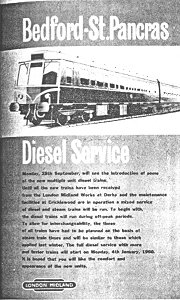
Poster advertising the start of provisional services. "Monday, 28th September, will see the introduction of some of the new multiple unit diesel trains. Until all the new trains have been received from the London Midland Works at Derby and the maintenance facilities at Cricklewood are in operation a mixed service of diesel and steam trains will be run. To begin with, the diesel trains will run during off-peak periods. To allow for interchangeability, the times of all trains have had to be planned on the basis of steam train times and will be similar to those which applied last winter. The full diesel service with more and faster trains will start on Monday, 4th January, 1960. It is hoped that you will like the comfort and appearance of the new units."
The Mayor of Bedford, Alderman C. N. Barrott, welcomed a party of guests during the first day at a ceremony at Bedford Midland Road. He expressed the satisfaction of his community that it's interests had been considered in effecting improvements to the service. The new trains would provide facilities better than those for which Bedford had hoped, and he was pleased that many others at intermediate stations would benefit.
In reply the London Midland Region General Manager David Blee stated that the new service was an example of how sensitive railway management was to the needs of the traveling public, although he said that the biggest difficulty in facing the demands of this kind was the time factor in producing the new rolling stock and in improving track, signaling, and intermediate stations. The people of Bedford and neighboring communities had asked for the new service. It had cost £2,500,000. He said that if their request was genuine they should now patronise it to enable British Railways to obtain a good return, and that he hoped the results would increase prosperity in the area.
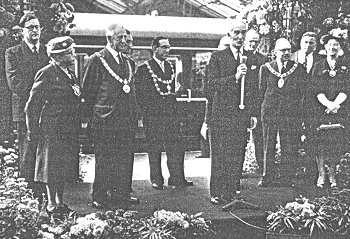
The image shows Mr Blee speaking at Bedford after the arrival of the inaugural diesel train on September 28th.
Attendees at the ceremony included JF Harrison, CME of the BTC Central Staff, from the LMR: EW Arkle, Director of Traffic Services; AE Robson, CMEE; RW Crawshaw, Public Relations & Publicity Officer; RLE Lawrence, Divisional Traffic Manager, London; WN Roberts, District Passenger Manager, Euston; JC Rogers, District Operating Superintendent, St Pancras; and CJ North, District Motive Power Superintendent, Kentish Town. There was also Mr Alan Lennox-Boyd, MP for Mid-Bedfordshire; Mr Christopher Soames, MP for Bedford; and the Mayor and other representatives of communities served by the new trains.
Full Implementation
This was put back a week to Monday 11th January 1960 because of a delay in completing engineering works, caused by a shortage of skilled building labour in the London area. The LMR made a vigorous effort to win traffic, with the combination of the comfortable new trains, the faster and more frequent services, and the introduction of a special cheap day return ticket to encourage off-peak travel. Parking facilities were improved at outlying stations to encourage people to 'park and ride'.
A promotional leaflet was made available to the public promoting the new trains:
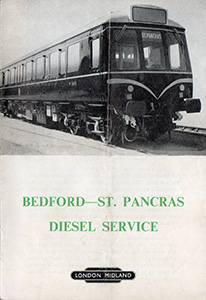
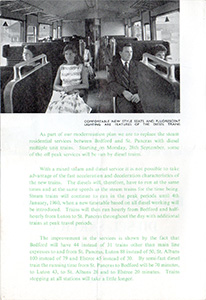
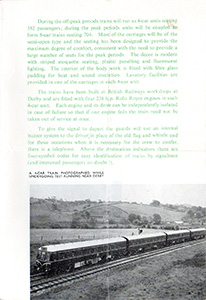
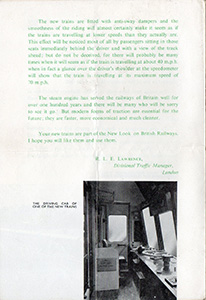
The general principle of the new timetable was one train leaving St Pancras at every hour for all stations to Luton, and one at 35 min past every hour for Elstree and all stations onwards to Bedford. With the eight intermediate stops the time to Bedford was no more than 69 mins for the 49.8 miles. In the opposite direction, the semi-fasts from Bedford and the stopping trains from Luton all left on the hour, resulting in a half-hourly service to and from Leagrave, Harlington and Flitwick.
The superior acceleration of the diesels made it possible to cut the headway over the bottleneck between Kentish Town and Finchley Road, allowing inconvenient gaps in the rush hours to be closed. There had been no train from St Pancras to Luton between 17:58 and 18:50, there was now a 17:55, 18:15, 18:48 and a 19:00. Bedford got a 08:30 to break the interval between the 07:55 (retimed to 08:05) and 08:53 departures. On Monday to Fridays, the last Bedford train left at 22:35 instead of 22:00 and was 20 minutes faster, and the last Luton left at 23:35 instead of 23:15.
The speeding up of the services saw some of the timings as fast as 21 mins for the 19.9 miles from St Albans to St Pancras, and 26 mins for the 24.6 miles from Harpenden. In the opposite direction the fastest services were 23 and 28 mins respectively. Some of the timings were faster than those to and from any other London Terminus over a corresponding distance. The improved signaling over the upgraded former goods lines, and the new platforms at Luton, Leagrave, Harlington and Flitwick made it possible to keep most of the stopping trains clear of the fast main lines, meaning minimal interference with the long-distance expresses.
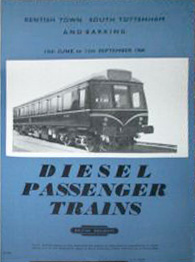
Services between Kentish Town and Barking were also taken over by DMUs on that day with an improved timetable, although this was critisised as most Kentish Town connections just missed the St Pancras - Luton stopping trains.
Initial Problems
Of the 30 sets built, 26 were required for peak periods, leaving only 4 spare for maintenance or other service requirements. But the sets, with the then new and non-standard transmission, were beset by various teething problems. In the peak hour periods, failures occurred at places and times which caused havoc to other services. Operating difficulties arose through having to adjust set workings, with trains running out of course. Trains had to be cancelled and additional stops inserted, and trains stopped short of their destinations to get a quick turnaround. Additional units had to be brought in - the very similar quad sets for services from Marylebone (later becoming Class 115), and some services returned to steam.
The problems were given prominence in the newspapers (such as The Daily Telegraph of 23/1/60) and aroused much criticism from the impatient traveling public. David Blee and his principal officers got involved, reviewing the cause of the trouble, the steps being taken to put it right, and a likely date when services would be back to normal. He said in a statement that none of the troubles experienced had shown up in the extensive trials the sets operated before the full introduction, which if they had would have been dealt with without materially affecting the service. He said the types of trouble could not have been foreseen, and the reserve of four sets has proven insufficient. A regular traveller replied to this, stating that he had " observed many disappointing features both in operating and in public relations, in most cases suggesting near-panic." Both railway and contractors staff worked day and night and weekends to correct faults and remove causes and senior officers kept a close daily check on train operations.
By the beginning of April 1960 the Region stated that most of the difficulties had been overcome. Passenger figures were also released for the month of February, the first full month of operation. The number of journeys by non-season ticket passengers rose by 19.5% compared with February 1959, from 261,180 to 312,221. Receipts increased by 24.3%.
In April 1960 a meeting was held, attended by Mr RLE Lawrence, Divisional Traffic Manager, London, LMR, and the Joint Committee of Local Authorities, to review the new services. The spokesman for the JC congratulated the railway management on the success of the scheme. The LMR stated it would increase the number of vehicles in service if this was found necessary and would remove the armrests between the seats to increase seating room.
The LMR announced at the end of July 1960 a passenger increase of nearly 20% on the line after a review of six-months operation.
It was claimed that the St Pancras Bedford service was the most intensified DMU service in Europe. The 26 daily diagrams daily (varying between 85 and 450 miles) involved running a total of 5,205 miles, meaning each set would work around 52,000 miles per year, and each set covered approximately 1.5 million miles in their lifetimes. The sets were built only for this one route, and rarely ventured from it, earning them the nickname of "Bed-Pan" units.
Other Workings

There was the occasional strayings. For several years in the mid-1960s the 2.35pm St Pancras to Bedford was extended to Gretton, which was between Corby and Manton, returning at 4.40pm. The image shows the staff of Gretton station, and the crew of the 5.55pm to Bedford, on the last day of services, 16th April 1966. Stuart Mackay Collection.
A mishap at Roade Junction on December 31 1969 resulted in sets being used for a short spell on a daily (including Sundays) evening non-stop run from St Pancras - Leicester. This was a connection for a Glasgow-bound sleeper service, the DMUs averaged a mile-a-minute on the 99 mile journey.[1]
In the late 1970s they worked a service from Kettering. The vehicles traveled out light to form the 05:45 to St Pancras. An eight car set worked a Bedford to Southend excursion on the 28th July 1973. The Pope's visit, and the ASLEF dispute in 1982, saw workings as far as Leicester.
Performance
These timings were noted on an inaugural run for a press party from St Pancras to Bedford, with an 8-car set. Kentish Town was passed at 51mph, and up the 1 in 182 through Belsize tunnel speed increased to 57mph. The short descent from Cricklewood produced a maximum of 70mph. The press, as they could now see the same view as the driver, quoted surprise at seeing that there was a 60mph speed restriction through Hendon as steam drivers showed scant regard for it. However, the driver on this press trip carefully eased the units down to 58mph through the station, which 6.9 miles from the start was passed in 8mins 17sec.
The most impressive part of the demonstration followed, as for the five mile climb to Elstree, mostly at 1 in 160-176 the speed rose steadily from 58mph to 70 mph and Elstree, 12.4 miles, was cleared in 13mins 20secs. The driver then eased off the throttle, so no higher maximum was reached than 72mph on the descent to Radlett, which was passed in 15 min 41 secs (15.2 miles). 'Even time' from the start was just attained at milepost 19, passed in 18mins 53secs, and with a slow stop St Albans, 19.9 miles was reached in 20 mins 23secs.
The 4.7 miles from St Albans to Harpenden, with the first mile from the start at 1 in 176 up, was run in 6mins 34 secs start to stop, the 74mph at which the Chiltern Green was passed was the highest of the journey, though in general the 70mph nominal limit for these units was closely observed. Thus down the long 1 in 200 descent from milepost 34, after leaving Luton, speed was restrained for almost the whole distance to a maximum of 71.5mph. Leasgrave, 2.6miles, was passed in 3mins 43secs; Flitwick, 10.0 miles in 10mins 4secs; and milepost 16 in 15mins exact; the rest of the run was spoilt by a long slack for drainage.
The same slack hampered the start of the up journey, but from Houghton Conquest the speed recovered up 1 in 200 from 20 to 66mph at Amphill. The controller was then moved back a notch, so that speed in the slight dip after Flitwick did not exceed 71.5 mph, and 70-69 was then maintained up the whole of the 1 in 200 to milepost 34. Because of the permanent way slowing, it took 11 min 5 sec to pass Amphill from Bedford (8 miles); the 12.5 miles to Harlington took 15mins 1 sec, the 17 miles to Leagrave 18min 57sec and the 22.5 miles to Chiltern Green 23 min 57 sec, including a 50 mph signal check at Luton and a re-attained 70mph before Harpenden Junction. From there onwards there were many checks and nothing of note other than a 69 mph up Elstree.

The image shows a St Pancras-bound 4-car set waiting at the old Bedford Midland station in June 1976. Kevin Lane.
Early Withdrawals
The first vehicle to be withdrawn was DMBS 51609 when less than five years old in April 1964 following a derailment between Glendon Junction and Kettering in December 1963. It was cut up at Derby Litchurch Lane in 1966. 51594 was withdrawn next in November 1966 after sustaining fire damage at Sandridge. The next month 59635 was withdrawn with accident damage at Cricklewood. 59601 went in June 1968 as "life expired", as was 59599 in December 1972.

51629 was withdrawn in January 1975 after fire damage while operating a 17:16 Luton to St Pancras football special on Saturday 11th January 1975. The image shows it the day after, probably taken in Cricklewood depot. British Railways.
On the 25th June 1976 an 8-car set had problems at Luton, and entered the crossover to gain access to the slow line. It was hit by the 18:18 St Pancras - Bedford unit, which was derailed across the fast line, and was subsequently hit by a St Pancras - Derby express. Fortunately there were no deaths, condemned were 51602, 51632, 59618, 59624 and 59630. These were taken to Litchurch Lane for scrapping, 51607 and 51617 also went along for repair. More details / images.
51591 was withdrawn in May 1977 but reinstated two months later. On the 8th November 1977 the 17:50 Bedford - St Pancras set collided with the rear of a St Albans - St Pancras set. Both DMBS's involved, 51601 and 51641 were beyond repair. 51631 was withdrawn in September 1979 after accident damage, and cut up at Cricklewood in February 1980.
Electrification
In the early 1980s the route was electrified with the Class 127s scheduled to be replaced by Class 317 electric multiple units in May 1982. At the time British Rail was ridding itself of as many DMUs containing asbestos insulation as possible. The 127s were asbestos free, but the availability of spare parts for the Rolls-Royce engines was a problem and so the power cars were scheduled for withdrawal when the EMUs were introduced.
However the introduction of single man operation on the the Class 317 EMUs caused union opposition, and the Class 127s had to struggle on for longer, while the new electrics sets sat unused. Keeping them going was a considerable task, as the planned rundown of the class had to be somewhat stretched. This caused an acute shortage of spares, which got so bad by December 1982 that an engine had to be taken from 51156, a Class 125 DMBS which had been in store at York as a potential departmental car. For the last few winters all serviceable units had to be left with their engines running overnight for fear of them not starting again, despite complaints from residents beside the stabling point.
Centre cars, in anticipation of being transferred to Tyseley once the EMUs took over, began to be turned out in blue and grey livery, and some of these appeared working out of St Pancras inbetween the blue power cars.

A farewell tour ran on the 12/3/83 from St Pancras taking in Bedford, Bletchley, Quainton Road, Marylebone, Neasdon and Acton Wells, before traversing the GWR main line to Slough. Damage to an air receiver en-route was repaired by the Quainton Railway Centre enabling the tour to continue. With the towers of the old Wembley Stadium in the background the image shows the tour standing at Wembley Complex. It was formed 51592 + 59615 + 59645 + 51618. Stuart Pearce.
Power cars 51594 and 51614 were severely damaged by a fire at the Bedford Stabling point on the evening of 1st April 1983. 51614 was cut up on site a week later by BR staff.
After their introduction problems continued with the 317s, and the 127s (many if not all were now formed as three cars) were temporarily re-introduced on to selected peak hour workings between St.Pancras and Bedford (generally with first stop being St. Albans) during the summer of 1983, and contributor Jonathan Rix noted there was a lot of furore in the local press about this.
On the 28th May 1983 two sets worked a Loughborough to St Albans charter.
The last booked St Pancras - Bedford working was the 21:53 from St Pancras on the 10/7/83 formed of 51646/59606/59643/51592. However, the next day saw three sets used on a Bedford - Flitwick shuttle because of engineering work.
Gospel Oak - Barking

Ten three-car sets were retained to replace Class 116s on the Gospel Oak to Barking line from 20/6/83, the 116s moving to Birmingham. This continued until sometime early in 1984, by which time many were been reduced to 2-car formations. Their replacements were cascaded Class 104's. The image shows power twin 51642 + 51597 waiting at Gospel Oak with the 12.15 to Barking on 11-2-84. On Tour With the Class 13 Army.
While waiting on sufficient servicable Class 104s from the Manchester Division, Cricklewood depot still had at least three Class 127 power twins in service on 5 March 1984 - 51596/51611, 51597/51642 and 51610/51640.
Disposal
Most of the power cars were withdrawn at the end of 1983, and put into store initially at Cricklewood.

In mid-1984 twenty power cars were moved to Carlisle for storage while further use was investigated, including a possible sale abroad[2]. The image shows DMBS M51612 stored at Carlisle Kingmoor Marshalling Yard on Saturday 9th June 1984. In 1985 all twenty would be converted to parcel units. Alicia Hartman.
In the second half of 1984 and early 1985 many of the power cars remaining at Cricklewood were stripped of common parts at Leicester TMD before making the short journey to Vic Berrys for cutting up.
Tyseley Centre Cars
The Birmingham depot received a TSL (59617) and TS (59623) in March 1978 which blended in well with their large fleet of Class 116s.
Asbestos Replacements [3]
Many of the trailers of the St Pancras Line Class 127 fleet were destined for a new life based at Tyseley Depot in the Birmingham area, with the vast majority destined to receive Blue/Grey livery and with some also receiving refurbishment. By the time the Class 127 trailers were to be rendered surplus, the preferred livery for many DMU classes was Blue/Grey.
Tyseley had seen a large fleet of Class 116 units based there from new, for use on the former GWR lines serving Moor Street and Snow Hill stations. By May 1978, the depot had accumulated an even larger fleet of Class 116 units, ready for the launch of the new “Cross City Line” service via New Street Station. Apart from a very small number of units, the Tyseley 116s had been through the BR refurbishment scheme to make them more suitable for use into the 1980s, and the initial white livery for refurbished DMUs had been superseded by Blue/Grey.
Most of the Class 116s were blighted by the presence of asbestos insulation, however the Class 127 trailers did not have this issue, and plans were made to transfer many of them to Tyseley once they had been displaced by the electrification of local services on the St Pancras Line. (For completeness, a small number of Class 127 trailers had already migrated to Tyseley prior to the run-down of the Class 127 fleet on St Pancras services).
The run-down of the Class 127 fleet on the St Pancras route was delayed by industrial relations and technical issues relating to the new EMU fleet. With a new life in the Birmingham area ahead of them, the overhaul programme for Class 127 trailers continued, and some of the vehicles were repainted Blue/Grey then returned to service on St Pancras line duties for a few months where they looked smart, especially when compared to the Class 127 power cars that had been kept going and that retained well-worn plain blue livery.
In total, 26 of the 30 built Class 127 TSL vehicles (all the survivors) moved to Tyseley, along with 18 of the TS (Trailer Second) fleet. A list of the vehicles can be found on the livery page.
For completeness, a small number of Class 127 trailers ran at Tyseley in plain blue, however all bar one eventually gained Blue/Grey.

The image shows TSL 59613 as the second vehicle in set T414 at Farington Curve Junction in May 1989. Marytn Hilbert.
They would last there a further ten years until October 1993, although the trailer seconds were withdrawn earlier than the trailer second lavatories.
References
Summary
Background
Description
Power Train
Interiors
Works Photos
Diagrams & Design Codes
Driving Instructions
Numbering
Liveries
Operations
Accidents
Parcel Use
Images
Details about preserved Class 127s can be found here.
Also relavant is the article "Working the DMUs" by Cricklewood Driver Arno Brooks.


